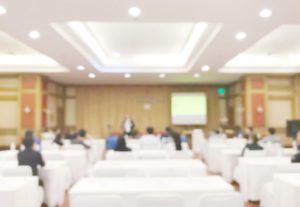 Organizing seating at events has traditionally been a pretty straight forward endeavor. It seems the biggest challenge has been to get people to sit up front as opposed to hiding in the back. Generally speaking, planners have had to decide if they want event seating in one of the following arrangement styles:
Organizing seating at events has traditionally been a pretty straight forward endeavor. It seems the biggest challenge has been to get people to sit up front as opposed to hiding in the back. Generally speaking, planners have had to decide if they want event seating in one of the following arrangement styles:
- Classroom - Tables in front of chairs arranged in rows. Optimal for events that require note taking.
- Table rounds - Round tables, generally seating 6 - 12 people based on the table size. Rounds are ideal for events with food service, but often cause half the attendees to have to turn their seats around to see speakers.
- Theater - Rows of chairs.
Today, as events are looking to be more interactive and inclusive, many organizers are looking beyond basic seating arrangements, and finding news ways for people to inhabit traditional meeting spaces.
Knowing one size does not fit all, the Corporate Event Marketing Association set up seating zones at their recent conference. These zones included:
- Connected and Casual - plush chairs with small fold-up tables big enough for a tablet or small laptop. These seats were geared toward note takers and people active on social media during the event.
- Styled and Structured - this was a more traditional theater set-up but with upholstered armchairs as opposed to standard banquet chairs.
- Collaborative Contemporary - stools were arranged around long, counter height tables, mimicking a coffee house set-up that many attendees are used to working in daily.
Another alternative seating option includes couches set-up as lounge areas. While these are more suited for networking spaces, they could work to create small collaborative "rooms" for an interactive keynote session requiring group discussions (think of it as a slightly more comfortable version of table rounds). For interaction between presenter and audience, the layout could incorporate a runway of sorts to bring the presenter into the crowd as opposed to relegating them to the stage.
Beyond looking cool, a seating layout has to make sense for the attendees. Things to consider include:
- Number of attendees -- The larger the crowd the fewer options you have to actually fit everyone in with a seat. Seating options that feature more comfort can also garner higher costs.
- Age demographics - Bar height seating, with or without backs, may not be the best option for a more mature audience. The same goes for seating that is lower to the ground.
- Note taking - Will attendees need to actively use a laptop or tablet? Will they likely be taking notes? Having a surface to perch devices on will be appreciated. Bonus points if you can also provide a way to charge their devices.
- Priorities - Is interactivity a goal of the event or is it more of a lecture style? If it is a lecture, think about giving people comfortable chairs in a more traditional theater set-up. If you're going for interaction, arrange the room for easy small group discussion. If it's a mix of both, use lighter chairs that can be easily moved
We'd love to hear from you. What creative room set-ups or seating arrangements have you tried? Share your thoughts in the comments.




